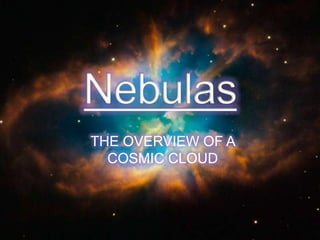
Nebulas
- 1. Nebulas THE OVERVIEW OF A COSMIC CLOUD
- 2. According to Merriam Webster: Neb-u-la :noun: ‘ne-bye-la 1: any of numerous clouds of gas or dust in interstellar Space What is a Nebula?
- 3. Nebulas are large clouds made of interstellar gas and dust They’re up of 98 percent hydrogen and helium and two percent heavier elements. They’re the beginning of new star or the remnants of supernovas. Properties of a Nebula
- 4. The term “Nebulas” is a general categorization of interstellar gasses. These clouds gather together and produce stars. The size of these stars produce different births and deaths. The Birth: Stars are born in cool dense clouds of Hydrogen and Helium. These clouds are in a molecular cloud stage. The Death: As stars begin to collapse under its own pressure they eventually explode emitting extremely hot gasses that are in an atomic stage. The birth and death of a star
- 5. Types of Nebulas There are five different types of nebulas Emission Nebulas Reflection Nebulas Supernova Remnant Dark Nebulas Planetary Nebulas
- 6. Reflection Nebulas: Dust and gas partials in reflection nebulas do not emit their own light. They reflect light from nearby stars. These gasses are in an ionized stage know as the “H II region”. Nebulas are in this reflective phase before they become emission nebulas. Reflection Nebula
- 7. Emission Nebulas: In this nebulas, a star is born and emits light. The radiation from these stars reacts with the dust and gas surrounding the star. Unique to these nebulas, the radiation from the stars actually excites surrounding atoms causing them to change energy levels making them glow as well. Emission Nebula
- 8. Dark Nebulas: Dark Nebulas are almost like cosmic overcast. They absorb light from stars behind them making them appear dark in comparison to surrounding clouds. Dust partials and gas absorb distant radiation and re-radiate causing them to emit inferred light from the absorbed energy. Dark Nebula
- 9. Planetary Nebulas: When a main sequence star grows too large it expels its outer layer of gasses in waves. These explosive stages appear as ripples of cosmic gases surrounding the star. Over time, the star cools and compresses and its inner core emits intense heat. The heat is so intense that is becomes radioactive. This activity gives the surrounding gasses there brilliant glow. When the stars fusion is exhausted, the star collapses. Planetary Nebula
- 10. Supernova Remnant Supernova Remnants: These nebulas are the scattered remains of what use to be a star or white dwarf. When this star/white dwarf meets its demise it produces a massive explosion. The explosion emits light equal to that of a galaxy and can sometimes be visible with the naked eye from earth.
- 11. Conclusion :The importance of nebulas Nebulas give scientists valuable information about the evolution and creation of stars. This information also gives us a look into the past and future of the universe. As these stars are born, they hold potential for new galaxies that could maintain life just as ours. However, they also tells us how our sun will die……… five billion years from now.
Editor's Notes
- Page 333 in the text book covers this information
